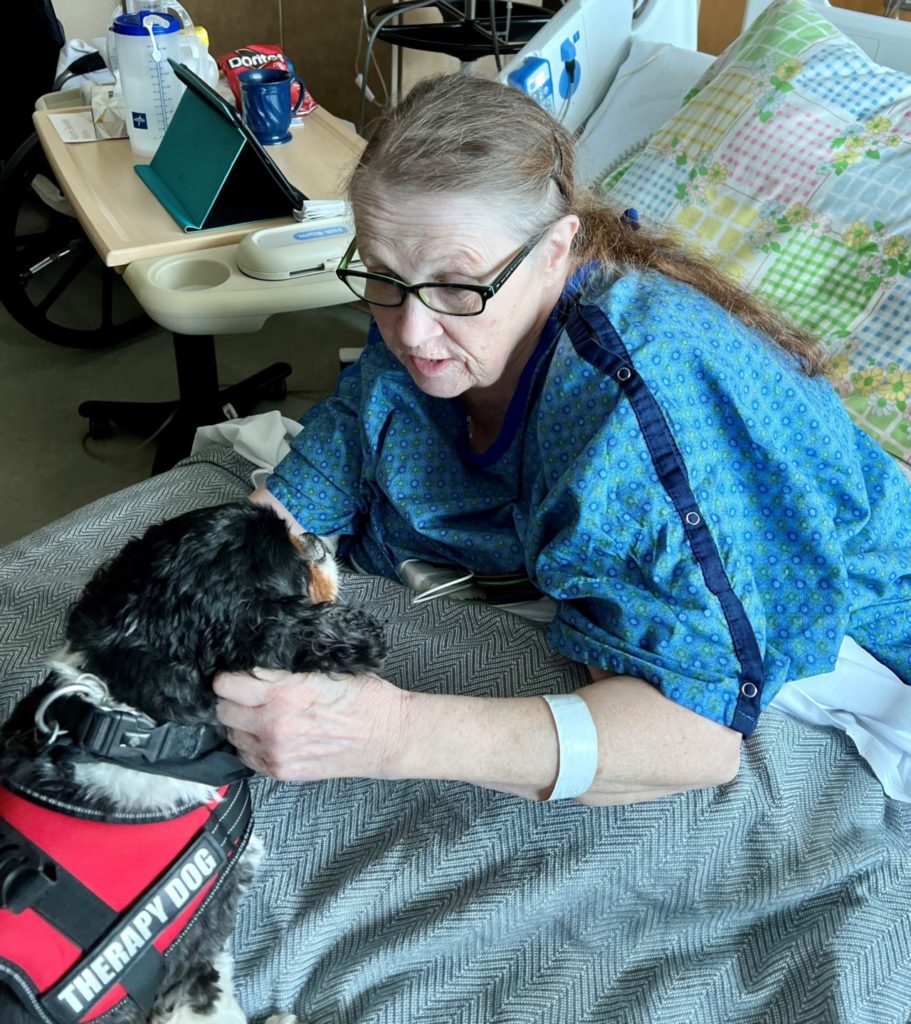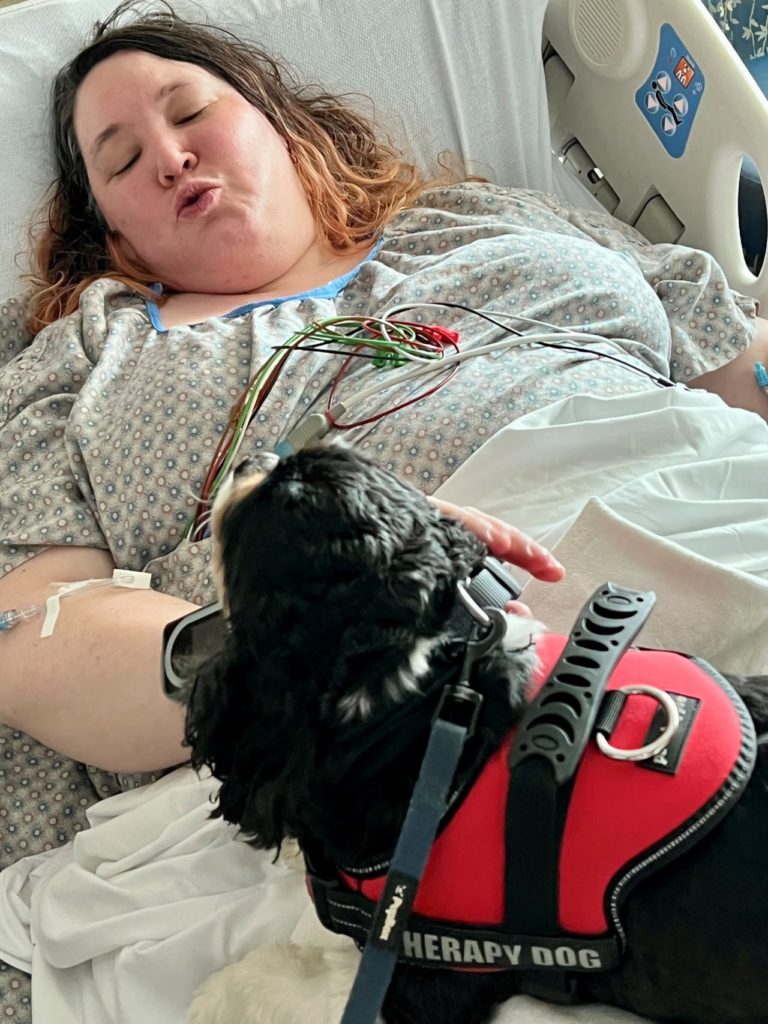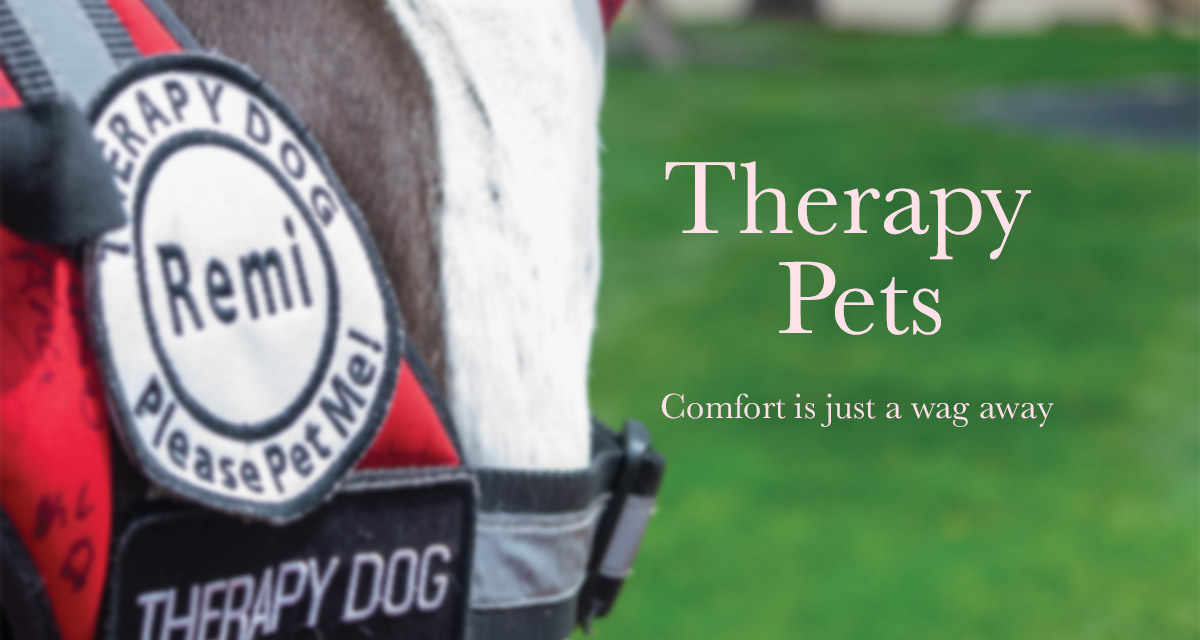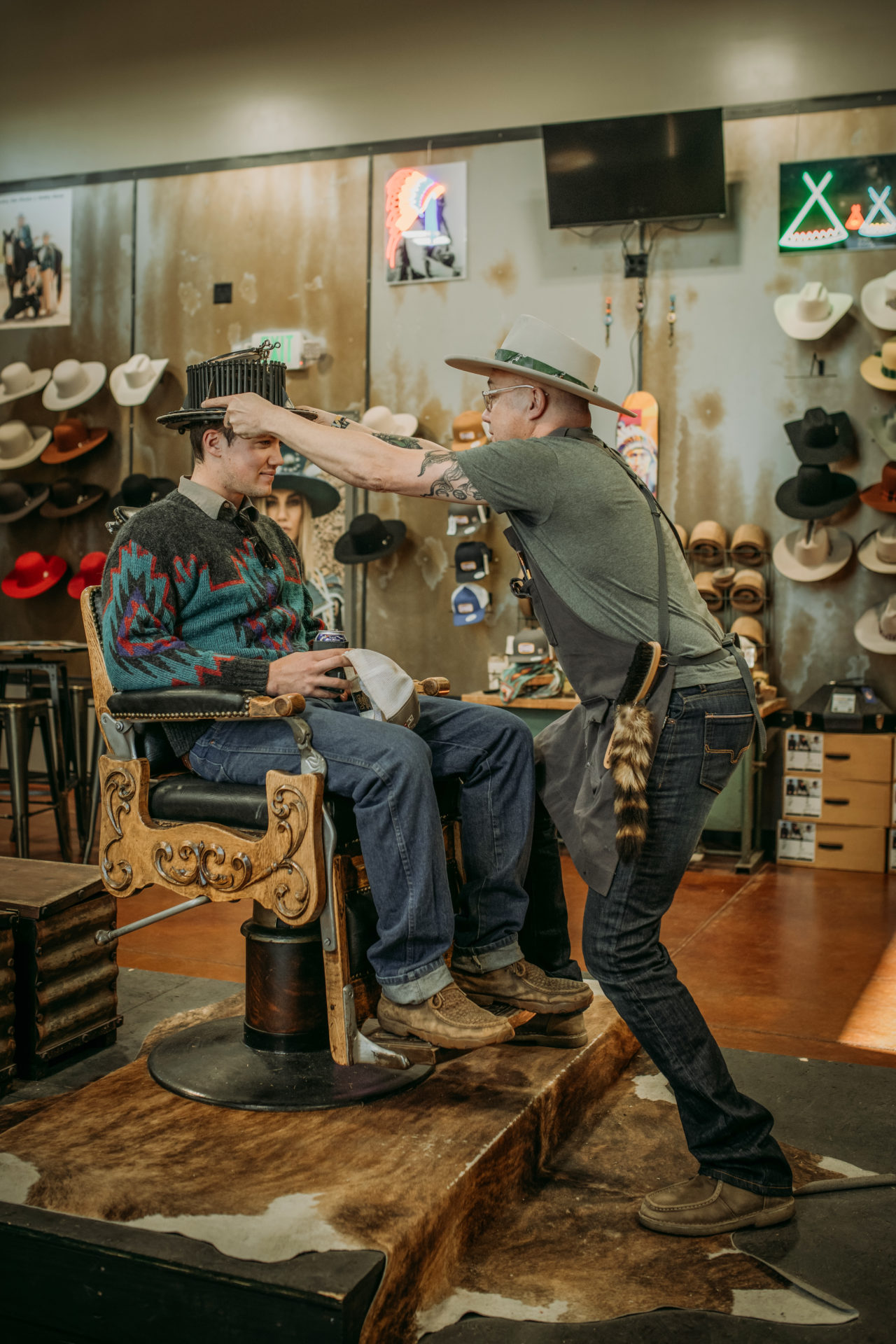By Dan England –
Molly Secher would love to show you around Realities For Children, the Fort Collins agency she founded with her husband, but be warned: A couple of her staff members are a bit too forward.
Actually, Remi is pretty polite. But Rio? Well, Rio is an HR nightmare: She may try to crawl into a lap or even give a gentle jump on your shoulders to deliver a kiss or some intense sniffing. She knows she’s not supposed to do this: She’s had dozens of hours of training with Mom (aka Secher). But just like the Oreo cookies in your cupboard, sometimes sweetness overrules willpower.

Remi and Rio, Realities For Children therapy dogs. Photos by Jordan Secher.
The overzealous love, however, is a minor infraction. It’s Remi and Rio’s job to offer affection and receive it in return. They are working dogs, and their red vests prove it. But this vest, unlike the others, says “Please pet me.” Rio is more than willing to convince you of your job if you are doubtful.
They are Molly and Craig Secher’s household dogs at night and when Molly runs in the morning.
But during the day, they are the face of the agency. They have their own baseball cards, and Scheels donated hundreds of stuffed shorthair pointers that act as toy Rios and Remis. They give the idea that Realities is a comforting, loving agency to frightened children instead of another uncertain, antiseptic strange place.
They put in a lot of work for the agency, which provides support in just about every way you can imagine to children in Northern Colorado who have been abused, neglected, abandoned or are at risk. The dogs are an icebreaker in schools—Remi makes those trips and has been rewarded with sappy love letters from Kindergartners—and provide comfort when it’s needed, which, given Realities’ mission, is often. Secher wanted to go through the training because it gave her a reason to meet the kids: She’d otherwise be stuck behind a desk all day as membership biller and relations manager (Craig is president).

Lucinda Edwards of Laramie, Wyo., a former school nurse, loved her time with Henry so much that she requested a second visit.
Therapy dogs aren’t service dogs, which can perform an amazing array of tasks for those with physical or emotional disabilities, and unlike nearly all service dogs, therapy dogs can be trained by their owners, although it takes more dedication than most are willing to put in.
But therapy dogs carry more credentials, and a lot more training, than emotional support dogs. Therapy dogs are typically golden retrievers because, well, if you’ve met one, you’d know why. But they don’t have to be: Remi, 5, and Rio, 3, are German shorthair pointers. That’s a hunting breed, but Secher learned from friends who owned them that they were smart and took well to training. Plus, they have gentle dispositions, especially after their morning runs.
The roles therapy dogs fill are as varied as the tasks service dogs are trained to perform, but their objectives are nearly universal. Hospitals, assisted living or nursing homes, schools, victims’ advocates and churches all use them, and they all have different requirements for allowing a therapy dog inside their inner circles for a helping paw in the worst of times. In addition to schools and events, Rio and Remi visit the agency’s 40 partner organizations that support kids.
“It’s not just for kids,” Secher says. “It’s parents, grandparents, caregivers, even case workers. We had a mom in here sitting on the floor who said, ‘I could really use a hug from a dog.’”
Most of the time, a therapy dogs’ job is to be a dog. They’re supposed to seek out people who need them and give kisses and allow pets. This comes naturally (especially for Rio).
But the training makes their behavior predictable, calm and, in case of an emergency, manageable. They won’t, for instance, snatch a Snickers out of a child’s hand, especially if Secher tells them to “leave it.” They will stay, sit and settle in a place until they’re called on to work. They won’t nip if a child tugs on their ears. They don’t mind big crowds or a dozen little ones rushing at them at once. Secher keeps a good eye on things, and she’s only allowed to handle one dog at a time, but just like any parent, she can’t watch her dog all the time. The training ensures she doesn’t have to.
It’s hard work, so at the end of the day, Remi and Rio get to take the vests off. “They definitely know when they are working,” Secher says to a guest. “If I took off the vests now and you saw them running around, you wouldn’t think they were therapy dogs.”
Wagging trails in the thick of tragedy
The dogs are cute and fun, but since they are also comforting, many times, their jobs aren’t necessarily fun. Jody Lockwood volunteers as a handler for Lutheran Church Charities. She’s just returned from Ulvade, Texas, where a gunman killed 17 children and two teachers and wounded 17 others in an elementary school. She handles Cubby, 8, and Devorah, 3.
“We just let the people cry on them and pet them,” Lockwood says. “It’s amazing how even some of the kids who survived that shooting were able to talk after they spent time with a dog. The [dogs’] heads have soaked up a lot of tears.”
Lockwood handles the dogs but she doesn’t own them. They work under Redeemer Lutheran in Fort Collins and live with full-time caregivers, one in Johnstown and one in Loveland. The dogs are a part of the Lutheran church’s ministry, though the handlers don’t push it too hard (Lockwood says she will pray with people only if they request it). Nationwide the program has 130 LCC K-9 dogs in 27 states.
Lockwood and the program prefer the title “comfort dogs” because of the training they undergo: It takes two years and 2,000 hours of training. Handlers spend an intense weekend passing tests that take hours of preparation, and they go through continuous training. They also have to be willing to go where they’re needed: Lockwood left for Ulvade 24 hours after the school district called LCC for a visit. She’s volunteered as a handler for four years and seen many life-changing circumstances. In fact, because the LCC K-9s are so highly respected, they get access to the worst of it, even the closed-off areas in horrible instances such as Ulvade that are deemed inappropriate for most anyone else or even other dogs.

Jamie Mann making a kissy face to Henry while she recovered from an illness.
“Cubby’s been on every deployment since 2015,” Lockwood says. “Every mass, awful shooting that’s occurred.”
Sure enough, Cubby was in Boulder after the Kings Soopers shooting, and Lockwood plans to be back one day soon. When Cubby isn’t working national tragedies, Lockwood will bring the dogs to North Colorado Medical Center (NCMC) or other local places.
“We do spend a lot of time with cancer patients at NCMC as they’re receiving treatment,” Lockwood says. “But even that is somewhat hopeful. Ulvade was awful.”
Therapy dogs are someone’s pet, Lockwood says, and usually handled by one person. Lockwood acts as Cubby’s main handler—they call her their “top dog”—but every K-9 is handled by as many as 10 people.
Lockwood doesn’t deride other therapy dogs. They do good work, she says, and remove some of the burden placed on K-9s.
“Everyone thinks their dog is a comfort dog,” Lockwood says, “and they are. But the K-9s are on a whole other level.”
This is not slave labor. The dogs get a “paycheck” for their hard work: Cubby loves massages and Devorah loves a game of ball. After a big trip, they get three days off, where they can just be a dog.
“But then they are good to go again,” she says. “They’re usually waiting by the door ready for someone to pick them up.”
Failure or friend?
Not all dogs make it through the service dog program, but if they fail, they can usually turn into overqualified therapy dogs.
Lucius, a golden retriever, was trained by Lynne Parks of Greeley, but Lucius failed through no real fault of his own: He foams at the mouth when he trains. The foam could cause problems for many tasks he would do as a service dog. But he’s a great therapy dog. Becca Overlock, as Lucius’ handler, fulfills two jobs as a part-time worker for Freedom Service Dogs and part-time worker for CBR YouthConnect. She makes home visits to kids and performs other services, including going to court with them, though she hasn’t had to do that yet.
“When a kid is suffering from depression, just getting out of the house is a struggle,” Overlock says. “But if I come in with a dog and suggest we go for walk, that’s more appealing than just their parents telling them to go outside.”
Lucius can also help kids feel comfortable talking about their emotions, as Overlock can help them relate to Lucius’ behavior, such as acting withdrawn or shy in a room full of people or at a dog park.
“Sometimes I have to make feelings up for Lucius,” Overlock says and laughs. “He’s pretty confident and friendly.”
As a therapy dog, Lucius gets to behave as a regular dog much more than as a service dog.
“That’s suited to him,” Overlock says. “He was having a lot of stress with guide work, but in this way, he gets to be a dog and interact. But those skills he learned from Lynne and others come in handy if we go into a more challenging situation.”
A+ bedside manner
After Janet Steward’s husband, Larry, finally succumbed to ALS nearly three years ago, she liked the way Hospice treated him so much in his final days that she began volunteering for them.
The work was rewarding, but she wanted to find another way to honor him and liked what she saw in hospital therapy dogs. Larry was a dog lover, but it was more than that.
“He spoke about love and kindness, and Larry lived his life that way,” says Steward, of Fort Collins. “What better way to honor him than with a dog?”
Dogs, after all, also live their life that way, or at least Henry does (and yes, we know your dog does too). She got Henry a couple years ago, and now he spends a couple days a week at Poudre Valley Hospital. Henry loves it. His favorites are the cancer patients: He can lay his 12-pound frame on their chest and deliver nose kisses. Henry isn’t actually supposed to lick, but patients usually brush away Janet’s admonishments.
“His tail starts wagging as soon as he walks through the hospital doors,” Janet says.
The therapy dogs in the UCHealth system are a good example of regular people training their pets to be therapy dogs. It’s hard work, as they typically must undergo obedience training and then canine good citizen training before they can be certified by a credible organization, such as the Alliance of Therapy Dogs, which means passing tests in potentially stressful situations, just like Secher and her two pointers. Then UCHealth puts owners through its own training, says Gaynel Tanner, who handles volunteer services at Medical Center of the Rockies, and requires some shadowing before the owners can finally see patients on their own. There are also background checks.
“We also interview the person and the pet,” Tanner says.
Finally, the dog can’t just be a really good dog. They have to be affable, seeking out pets and attention and want it. It’s OK that the dogs are tired by the end of their rounds—two hours usually wipes Henry out—but when they’re working, they should deliver as much love as possible.
Still, Steve Stetler, of Loveland doesn’t think the training is a big deal if your dog is calm, obedient and as friendly as his Bernese Mountain Dog, Tonka. Tonka is the opposite of Henry (in size, not in love), as he could crush patients if he hopped on their beds. But he’s big enough to rest his head on the sheets for scratches. Stetler has volunteered his therapy dogs for six years.
“We have about 100 things they examine us on,” Stetler says, “but it’s really just ways to measure if your dog is calm and fun.”
Patients love both Tonka and Henry, but so do the nurses and doctors and anyone else who comes across their path, such as those in waiting rooms. Most of the workers know Tonka, and Tonka knows them and where they keep treats. Medical workers need the dogs as much as the patients, says Jamie Mann, a nurse navigator in MCR. It was a blow when the dogs weren’t around during the worst of the pandemic.
“I love the dogs,” she says. “I’ve been here since we opened and that’s always the highlight of the week. We say they are more for the staff than the patients, especially with the way things have been lately.”
Not everyone loves dogs, and patients can say no to a visit. But most of them squeal with excitement when they see a dog walk in, such as Jenny Tenbrink, a Fort Collins woman recovering from an illness. Henry assumed his usual spot on the bed and eventually settled between her legs.
“I have cats at home, but they can’t be here with me, so this is really nice,” Tenbrink says. “I think Henry should just take a nap with me.”
Stetler and Tonka have their own reasons for doing it, and a lot of it has to do with his wife, Beth, who is in the throes of Parkinson’s Disease. Beth gets a lot out of Tonka as well. But there is another reason: Stetler and Tonka both love seeing people, even if all the nurses seem to know Tonka’s name and not his.
“We are treated like kings here,” he says.
__________________________________
Dan England is NOCO Style’s assistant editor and a freelance journalist based in Greeley.






